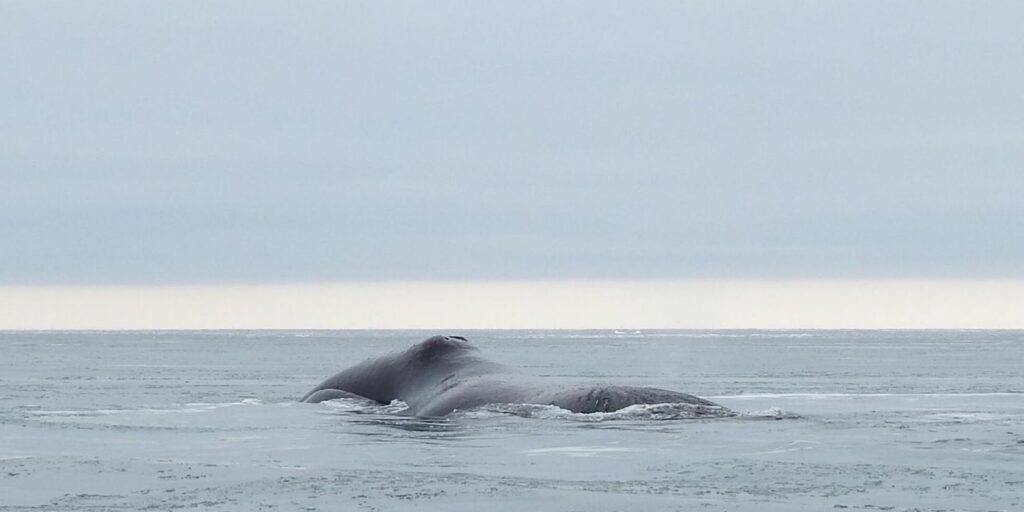Bowhead whales are on their way to Canada for the summer months, and whaling communities in the Bering Strait region have reported a successful spring hunting season. Despite these annual events continuing as normal, researchers have recently found some bowheads deviating from their usual movements.
KNOM’s Davis Hovey reports:
Bowhead whales are creatures of habit. They spend their summers in the Amundsen Gulf and the Tuktoyaktuk Shelf region of Canada and then migrate along the northern coast of Alaska past Utqiagvik, before going south to the Bering Sea, where they stay for the winter.
“Bowheads leave the Bering Sea in April, right before it becomes the most productive ocean in the world…(*chuckles).”
Lori Quakenbush is with the Alaska Department of Fish and Game (ADF&G) and has been studying these specific whales, using satellite telemetry, for more than 14 years.
She says researchers believe that bowhead typically travel to places where their food, like zooplankton, is heavily concentrated.
“So in spring, in April and May, they follow northward closest to Alaska Coast and then when they get to Point Barrow, they actually go a little bit beyond Barrow before they turn right, and then they pretty much go straight shot to Canada from there, which is really interesting. They’re out over the deep water under Beaufort sea ice, that’s probably at about the heaviest it is during the year, so they’re doing that in May.”
The annual migration of bowheads normally puts the massive marine mammals around Point Barrow in the spring and then again sometime between late August and October.
But suddenly, last fall, the community of Utqiagvik and Quakenbush experienced something that had never happened before.
“One of the big changes was last year in the fall whaling season in Utqiagvik basically didn’t happen and unfortunately we didn’t have any tags out to say exactly where those whales were. The aerial survey folks found some, really late for normal migration, still in the Beaufort Sea.”
Veteran whalers told Alaska Public Media last year that the community of Utqiagvik had never gone that long without seeing a bowhead whale near Point Barrow during the fall hunting season. Alaska’s northernmost community did land one whale last November, however it paled in comparison to the almost 20 whales Utqiagvik harvested during the 2018 fall season.
As Gay Sheffield with Alaska Sea Grant puts it, communities in the Bering Strait region are greatly interested in where bowhead whales will be spotted next, following these unusual movements from the past fall season.
By that time in the bowhead’s migration, Quakenbush’s satellite tags had stopped transmitting information and funding for the project ran out. She says that was unfortunate timing for more than one reason. The project officially ended in 2018, but the final satellite tags on bowheads continued to transmit data into 2019. None were still active by the fall whaling season according to Quakenbush.
“And we’re also seeing this shift in the wintering area in the Bering Sea and we don’t have an opportunity to track that now. We did learn a lot and we learned a lot about (what) bowheads were doing with the ice conditions that were pretty stable at that time, and now that they’re changing we’re not sure what we know.”
Quakenbush and other researchers are seeing ecosystem-wide changes, like the warming Bering Sea, but also, more specifically, bowheads starting to change where they spend their winters. During recent warm winters in the Bering Sea, bowheads spent more time in the southern Chukchi Sea than in their normal wintering area south of Bering Strait.
Other movements, unrelated to warming ocean temperatures, were also found.
Quakenbush says some bowheads are traveling twice as far on their journey west from Canada and then back east from the Beaufort Sea.
“We have a fair number of whales that leave the Canadian Beaufort, go all the way over to the Chukchi and then back to the Canadian Beaufort, before they migrate back in the fall; which seems like a pretty long distance. But there’s some really interesting movements of leaving, either to look for another place to feed, or we don’t know… But they’re basically traversing the Beaufort Sea twice in the same season.”
Quakenbush and the research team, made up of local subsistence whalers, tagged more than 77 bowhead whales between 2006 and 2018. She mentions that this is a small sample size relative to a bowhead population estimated to be more than 16,000.
As the Alaska Eskimo Whaling Commission has told KNOM, subsistence hunting for bowheads and other marine mammals is a way of life that AEWC members will continue, regardless of external factors. Both Savoonga and Gambell successfully landed bowheads by the end of the spring hunting season. The community of Point Hope reportedly met their quota of 11 this season.
Similarly, Quakenbush’s work has come to an end. The satellite tagging project she was involved in, tagged its last set of whales in the fall of 2018.
At this point, Quakenbush says she is analyzing the data to be able to share more information about bowheads’ movements with whaling captains and other interested stakeholders.
Image at top: Bowhead whale surfacing near Gambell in late April, 2020. Photo from Clarence Irrigoo Jr. of Gambell, shared via public domain (social media).




